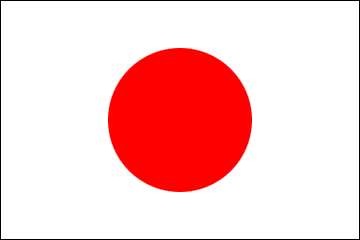October 5, 2021: Visit to the town of Topoľčany
2021/12/8
October 5, 2021: Visit to the town of Topoľčany (part 1) - A unique Slovak system of compulsory education
On 5 October, I visited the town of Topoľčany, located in the north of the Nitra self-governing region, in the eastern part of the Topoľčany district. This was my first visit to this city and took place at the invitation of the mayor, with whom he had previously met at a concert in Kremnica. They have already agreed to visit the city.
The visit began with a meeting and an interview at the town hall, after which I visited the oldest primary school in the city, which was founded in 1903. Compared to Japan, the school system in Slovakia is different in that it attaches importance to comprehensive child development. subjects such as mathematics, mother tongue, foreign languages, natural and social sciences, but also through the arts, such as music, fine arts or theater. Based on such a policy, there have been two parallel systems since primary school. One focuses on teaching compulsory subjects and the other on non-compulsory subjects, including art. From the first year of primary school, pupils have the opportunity to continue in the afternoon classes in elementary art school after the compulsory teaching of subjects in the afternoon.
During his visit, I visited the historic premises of a primary school with a history of almost 120 years where daily teaching takes place. I also had the opportunity to look into the classes, where students spending time. I received a truly traditional and sincere welcome with bread and salt. This was followed by folk dance; an action drum shows and musical performances by students of the local art school on the stage of the school theater. For all the students, whether they were children from lower or higher grades, I was impressed by their kind smiles and glowing faces. From their performances, I felt that I had come to an amazing school in which students fully enjoy their student life. I felt that there was something to learn from this model, and it was really important to emphasize art from the lowest years of compulsory education.
Baron August Stummer, a leading local businessman, provided great support in founding the school almost 120 years ago. Some parts of the complex are still the same as then. The Baron not only supported education and training, but invested his own money in the development of the city and helped to establish a local hospital or the development of agriculture. I was impressed that an enlightened rich man lived in Topoľčany, a small Slovak town 120 years ago. When I asked his hosts what had happened to the Stummer family, he learned that their entire property had been confiscated after the onset of communism and they had to leave the country. I thus thought about what would happen if such a virtuous and rich man as the baron took the lead today ...
October 5, 2021: A visit to the city Topoľčany (part 2) - Visiting Apponyi Library (Bibliotheca Apponiana) in Oponice
Then I visited Apponyi library in the village of Oponice, which arranges Mayor Topoľčany, Ms. Alexandra Gieciová.
The Apponyi family (after the Hungarian name of the village of Oponice) was one of the influential aristocratic families during the Austro-Hungarian monarchy during the Habsburg rule. They derived their name from the Hungarian form of the name of the village Oponice. The library began to be built in the second half of the 18th century and slowly grew to about 30,000 volumes.
The book collection, which began to be built in Vienna, was later moved to Pressburg (today's Bratislava) and served as a public library. After disagreements with the city, Count Apponyi had it moved again to Oponice, to the family manor house in the park and had it built a separate gallery, known as the North Wing. After the First World War and the demise of Austria-Hungary, the family left the castle, but the books remained in it. The fate of the library was sealed after 1948, when it was nationalized by the communists together with the manor house. There was a period of its devastation and decline. The rescue for the rare library collection did not come until the 1970s, when the books were transferred to the depository of the National Library in Martin, but many were lost or irretrievably damaged.
This is a valuable collection of historical books from the early modern period and the modern age. During the visit, I was able to overlook a section of it that now reads more than 20,000 books (such as Newton's report on the discovery of universal gravity, Copernicus's book on the theory of heliocentrism, or Giovanni Boccaccio's Decameron bound in leather). From the point of view, it is clear that this is a unique collection of extremely rare books. In its premises, I was able to clearly imagine the life of an important aristocrat living during the Austro - Hungarian monarchy.
Such a wonderful collection of books of the Apponyi family secretly sleeps in a small town in Slovakia, in Oponice.
The more I found out, the more he was impressed by how many wonderful things there are in Slovakia.
October 5, 2021: A visit to the city Topoľčany (part 3) - visit places closely connected with the Great Moravian Empire
At the last item on the agenda was with the Mayor of Topoľčany Alexandrou Gieciová moved to the village Bojná, where they visited the Archaeological Museum of Great Moravia. The Municipal Office is located in the same building, where they were welcomed by Mayor Jozef Stankovský.
The Great Moravian Empire originated around the 9th century in the territory of western Slovakia, the Czech Republic, Austria and northern Hungary, and was a state of the Western Slavs and the first major Slavic state at all. It is said that its center was near today's Nitra. The history of Slovakia allegedly begins in the period of Great Moravia. In the mountains that line the river Bojná, there are ruins of the fortified settlement and settlements from that time, and excavations are still continuing. The artifacts are exhibited in the Archaeological Museum in Bojná.
In the second half of the 9th century, the Thessalonian brothers Constantine (Cyril) and Methodius came to their territory from present-day Slovakia. They were sent by the then Byzantine emperor to spread Christianity, which was of great historical significance. The evangelists mastered the language of the people they were to go to and created the first script in the history of the Slavs. In many Slavic countries, Cyril and Methodius celebrations are a national holiday.
However, excavations in the locality of the fortified settlement Bojná have brought important evidence that Christianity was present in the Great Moravian Empire before the mission of Cyril and Methodius. In the museum you can see gilded copper plates with motifs of angels, which are believed to have decorated a chest for important artifacts, or copper bells, whose faithful replicas even give off a tone. The small Slovak village of Bojná is simply a place that proves the deep history and tradition of Christianity among the Slavic nations.
I believe that it depends on each person how impressed he will be, but this is a very important historical fact in the Slavic region stretching from the Balkan Peninsula to Russia. The mayor of Bojná is a man extremely passionate about the history of his village. He even had a replica of a found copper bell made and handed it over to Pope Francis in the Vatican.
The surroundings of Topoľčiany, located in the north of the NSK, are a gentle, idyllic hilly area located on both banks of the Nitra River. You won't find much information about this piece of land in the tourist guide around Slovakia either. For me, however, it was a day when he fully knew that it was a place with a story that is indispensable when talking about the history of Slovakia. We would therefore like to sincerely thank the city of Topoľčany for inviting them.
On 5 October, I visited the town of Topoľčany, located in the north of the Nitra self-governing region, in the eastern part of the Topoľčany district. This was my first visit to this city and took place at the invitation of the mayor, with whom he had previously met at a concert in Kremnica. They have already agreed to visit the city.
The visit began with a meeting and an interview at the town hall, after which I visited the oldest primary school in the city, which was founded in 1903. Compared to Japan, the school system in Slovakia is different in that it attaches importance to comprehensive child development. subjects such as mathematics, mother tongue, foreign languages, natural and social sciences, but also through the arts, such as music, fine arts or theater. Based on such a policy, there have been two parallel systems since primary school. One focuses on teaching compulsory subjects and the other on non-compulsory subjects, including art. From the first year of primary school, pupils have the opportunity to continue in the afternoon classes in elementary art school after the compulsory teaching of subjects in the afternoon.
During his visit, I visited the historic premises of a primary school with a history of almost 120 years where daily teaching takes place. I also had the opportunity to look into the classes, where students spending time. I received a truly traditional and sincere welcome with bread and salt. This was followed by folk dance; an action drum shows and musical performances by students of the local art school on the stage of the school theater. For all the students, whether they were children from lower or higher grades, I was impressed by their kind smiles and glowing faces. From their performances, I felt that I had come to an amazing school in which students fully enjoy their student life. I felt that there was something to learn from this model, and it was really important to emphasize art from the lowest years of compulsory education.
Baron August Stummer, a leading local businessman, provided great support in founding the school almost 120 years ago. Some parts of the complex are still the same as then. The Baron not only supported education and training, but invested his own money in the development of the city and helped to establish a local hospital or the development of agriculture. I was impressed that an enlightened rich man lived in Topoľčany, a small Slovak town 120 years ago. When I asked his hosts what had happened to the Stummer family, he learned that their entire property had been confiscated after the onset of communism and they had to leave the country. I thus thought about what would happen if such a virtuous and rich man as the baron took the lead today ...
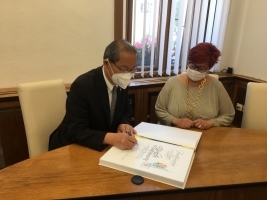 |
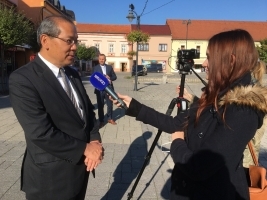 |
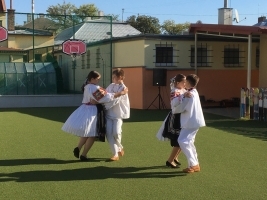 |
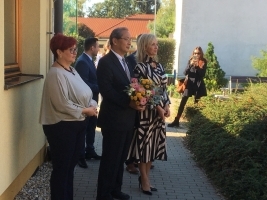 |
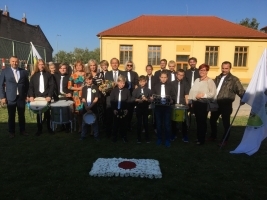 |
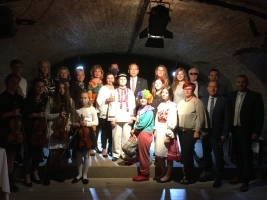 |
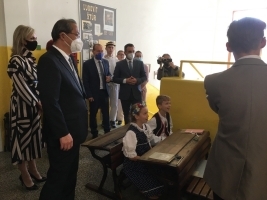 |
October 5, 2021: A visit to the city Topoľčany (part 2) - Visiting Apponyi Library (Bibliotheca Apponiana) in Oponice
Then I visited Apponyi library in the village of Oponice, which arranges Mayor Topoľčany, Ms. Alexandra Gieciová.
The Apponyi family (after the Hungarian name of the village of Oponice) was one of the influential aristocratic families during the Austro-Hungarian monarchy during the Habsburg rule. They derived their name from the Hungarian form of the name of the village Oponice. The library began to be built in the second half of the 18th century and slowly grew to about 30,000 volumes.
The book collection, which began to be built in Vienna, was later moved to Pressburg (today's Bratislava) and served as a public library. After disagreements with the city, Count Apponyi had it moved again to Oponice, to the family manor house in the park and had it built a separate gallery, known as the North Wing. After the First World War and the demise of Austria-Hungary, the family left the castle, but the books remained in it. The fate of the library was sealed after 1948, when it was nationalized by the communists together with the manor house. There was a period of its devastation and decline. The rescue for the rare library collection did not come until the 1970s, when the books were transferred to the depository of the National Library in Martin, but many were lost or irretrievably damaged.
This is a valuable collection of historical books from the early modern period and the modern age. During the visit, I was able to overlook a section of it that now reads more than 20,000 books (such as Newton's report on the discovery of universal gravity, Copernicus's book on the theory of heliocentrism, or Giovanni Boccaccio's Decameron bound in leather). From the point of view, it is clear that this is a unique collection of extremely rare books. In its premises, I was able to clearly imagine the life of an important aristocrat living during the Austro - Hungarian monarchy.
Such a wonderful collection of books of the Apponyi family secretly sleeps in a small town in Slovakia, in Oponice.
The more I found out, the more he was impressed by how many wonderful things there are in Slovakia.
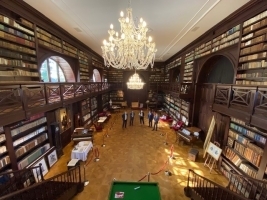 |
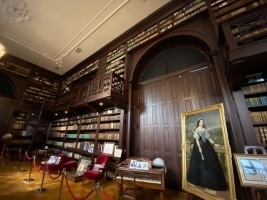 |
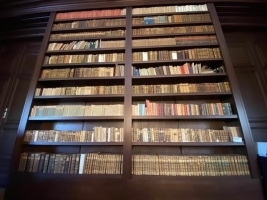 |
October 5, 2021: A visit to the city Topoľčany (part 3) - visit places closely connected with the Great Moravian Empire
At the last item on the agenda was with the Mayor of Topoľčany Alexandrou Gieciová moved to the village Bojná, where they visited the Archaeological Museum of Great Moravia. The Municipal Office is located in the same building, where they were welcomed by Mayor Jozef Stankovský.
The Great Moravian Empire originated around the 9th century in the territory of western Slovakia, the Czech Republic, Austria and northern Hungary, and was a state of the Western Slavs and the first major Slavic state at all. It is said that its center was near today's Nitra. The history of Slovakia allegedly begins in the period of Great Moravia. In the mountains that line the river Bojná, there are ruins of the fortified settlement and settlements from that time, and excavations are still continuing. The artifacts are exhibited in the Archaeological Museum in Bojná.
In the second half of the 9th century, the Thessalonian brothers Constantine (Cyril) and Methodius came to their territory from present-day Slovakia. They were sent by the then Byzantine emperor to spread Christianity, which was of great historical significance. The evangelists mastered the language of the people they were to go to and created the first script in the history of the Slavs. In many Slavic countries, Cyril and Methodius celebrations are a national holiday.
However, excavations in the locality of the fortified settlement Bojná have brought important evidence that Christianity was present in the Great Moravian Empire before the mission of Cyril and Methodius. In the museum you can see gilded copper plates with motifs of angels, which are believed to have decorated a chest for important artifacts, or copper bells, whose faithful replicas even give off a tone. The small Slovak village of Bojná is simply a place that proves the deep history and tradition of Christianity among the Slavic nations.
I believe that it depends on each person how impressed he will be, but this is a very important historical fact in the Slavic region stretching from the Balkan Peninsula to Russia. The mayor of Bojná is a man extremely passionate about the history of his village. He even had a replica of a found copper bell made and handed it over to Pope Francis in the Vatican.
The surroundings of Topoľčiany, located in the north of the NSK, are a gentle, idyllic hilly area located on both banks of the Nitra River. You won't find much information about this piece of land in the tourist guide around Slovakia either. For me, however, it was a day when he fully knew that it was a place with a story that is indispensable when talking about the history of Slovakia. We would therefore like to sincerely thank the city of Topoľčany for inviting them.
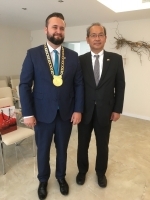 |
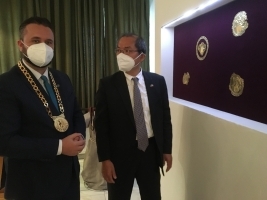 |
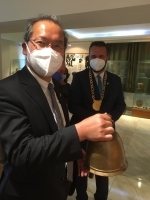 |
